The Viracocha expedition
In 2000 and 2003, professional explorer Phil Buck led international teams across the Pacific Ocean from South America to Easter Island via two separate ancient style reed rafts. Both vessels were constructed in their entirety from only four Andean materials; totora reeds, natural fiber rope, cotton sails and wood.
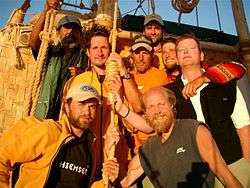
No one in recorded history has been able to reach the most isolated populated island in the world aboard an any ancient style vessel of any kind. The Viracocha expeditions proved that ancient South American mariners could have been the first to discover Easter Island. Who first reached the island and carved the numerous stone monoliths (or Moai) still remains one of antiquity's greatest mysteries and has baffled the scientific community for centuries.
The Viracocha I expedition
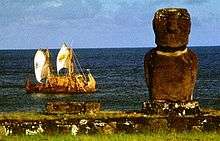
Inspired by world-famous explorer Thor Heyerdahl before his death, Buck's plan was to support the theory that ancient South American voyagers crossed vast ocean expanses in various types of boats including the ancient style reed raft that were quite possibly the key factor of human migration and the spread of civilization. The expedition set sail from Arica, Chile and completed the voyage to Easter Island, Polynesia in 44 days in 2000. It was the first primitive boat of any kind to reach the island in modern times.[1]
Controversy
Kitín Muñoz, the leader of previous pacific reed boat expeditions,[2] criticized Viracocha in the press, claiming that the use of synthetic rope in the boat construction made the experiment invalid. According to the builders, they did use a small amount of synthetic twine, but judged that the effect on the durability of the boat was negligible.[1]
The Viracocha II expedition
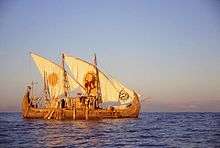
In March 2003, a team of eight men, again led by Phil Buck, set sail from Vina del Mar, Chile aboard a completely new reed raft, the Viracocha II, in an attempt to sail 10,000 nautical miles across the entire Pacific Ocean to Cairns, Australia, via Easter Island and other islands of Polynesia.[3][4] The raft was severely damaged during the launch[5] and the team was unable to test the raft to its full potential. Even with the starboard side damage, the raft still managed to make the long traverse to Easter Island for the second time.
Reed rafts
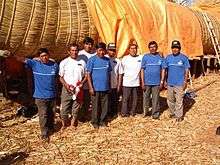
Reed raft building is one of the oldest maritime technologies. Throughout history, reed rafts have been constructed in almost every part of the world where reeds have grown, most notably in regions near the Mediterranean, in South America and Easter Island. Today only a handful of places still practice the ancient art of reed raft construction. The Aymara reed boat builders of Bolivia's Lake Titicaca are the foremost builders in the world today having built the hulls of Viracocha I and II. The art of reed boat building has been passed down through generations and survives on both the Peruvian and Bolivian sides of the lake. Reed boat building is now mainly a tourist attraction and wooden boats, which last much longer, have now taken over as the main vessel on the lake.
Where were the first reed boats built? Were ancient mariners able to cover large distances in reed rafts? Did ancient cultures utilize the ocean currents and winds as highways rather than barriers in search of new lands? Were the ancient navigators able to find their way across endless miles of ocean? These are questions the scientific world has debated for centuries.
The expeditions of explorer/anthropologist Thor Heyerdahl captured the imagination of the world with the Kon-Tiki balsa log raft voyage on the Pacific in 1947, his Ra Expedition, a reed raft journey across the Atlantic in 1970 and his Tigris reed boat voyage on the Indian Ocean in 1978.
How reed rafts are built
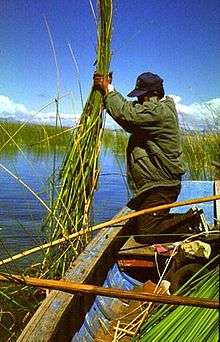
The Viracocha I and II were 64 feet (20 m) long, 14.85 feet (4.53 m) wide at the center-line and weighed approximately 20 tons. Two and half million reeds were required for each boat and were harvested from the shores of the Bolivian/ Peruvian high altitude Lake Titicaca, where the totora reeds grow in abundance. The reeds were cut with a long cutting pole from small rowboat and bundled up into "amaros" (bundles) with roughly 500 reeds per bundle. They are rowed ashore and sun dried for two to four weeks with bundles stacked together in a standing position. After the drying process, the reeds are gathered up and stored, being careful to keep them from the rain. The reeds (Scirpus Riparius) are generally one half inch thick at the base (before being compressed) and 6 feet long.
The reeds are then made into over 30 long cylinders or "chorizos", 1.5 feet (0.46 m) in diameter which are made the length of the boat. These form the main bulk of the ship. The jig is built next. This serves as a mold, constructed with eucalyptus poles every three feet, running perpendicular to the hull supported by poles from the ground. Two smaller boats that looked similar to "whales" are made to add rigidity to the boat with the technique the same as main hull, described later. They are laid side by side on top of the mold. The roles are laid on top of the "whales" until they form two large separate bundles.
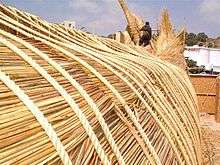
The "estera" or skin of the boat is the next phase and is made by weaving the best stock of the reeds, made the length of the boat. This skin is wrapped around the two large bundles. A heart, or third bundle is placed in the center of the much larger bundles. Two strands of sisal rope, each 2250 feet in length is than passed around one large bundle and around the heart in one foot revolutions for the entire length. The same is done on the other side. Never does the rope wrap around the whole ship.
The rope tightening is next. A pulley system is used to haul on the boats to get them gradually tighter. There are only two long continuous ropes, 2,250 feet on either side. The pulling begins on one end and is hauled on until taut. The ropes are pulled roughly thirty more times on each side, shrinking the size of the boat each time. This ingenious design now consists of two large bundles linked together by a heart that has now disappeared into the larger two bundles forming a stable, almost double hulled vessel.
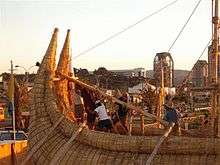
The next phase is to build up the bow and stern. Tapering cones of reeds are wedged together until a high bow and double stern are formed. The double stern adds more stability and carrying capacity to the ship while at sea.
Attaching the two large bundles that form the gunnels or "sawi" is the last step of the hull construction. Rope is wound around each gunnel and passed through each main bundle rope along the length of the ship. The rigging will be attached here and the gunnels help break the larger waves.
The crew and volunteers constructed the rest of the vessel. Two bipod masts were positioned on either side of a bamboo cabin for Viracocha I and a smaller mast was utilized further aft for the Viracocha II. The masts were held in place by "shoes" roped into the bundles. Two rudder oars were lashed to a steering platform placed above and to the rear of the bamboo cabin. The ship was rigged with natural fiber sisal rope, the same rope that holds the reed bundles together. Two center boards were positioned in the slide boxes placed in the fore and aft of the ship and aided in the tacking into the wind. Several lee-boards were placed on the lee-side of the ship and were removable. Two cotton lateen sails were hand-sewed for the first journey and five sails were used for the second.
Scientific significance of the expeditions
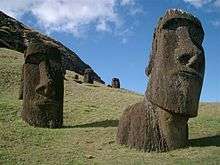
The problem of how Polynesia was settled has caused more controversy than any other puzzle in the history of anthropology. Did the original settlers migrate from the west and Asia or did they come from the East and South America? There is no doubt that Asia had a major part in the human migrations that peopled most of the Pacific but there were other possibilities from other directions that have been discredited by many experts and perhaps they occurred much earlier than any migration from Asia.
Many anthropologists discount the possibilities of contact from South America, reasoning that the boats available to the native South Americans in the past millennia, and the navigators who sailed them, were not able to make long, open ocean voyages. Contrary evidence has been uncovered throughout South America, such as drawings depicting reed rafts provisioned with supplies and water for long voyages. The elements favor a western movement for prevailing sea currents and winds that sweep across the South Pacific directly from the Chilean/Peruvian Coast, where ancient Pre-Inca civilizations regularly plied the coasts in reed and balsa lografts. Sailing against these natural migration routes would have been difficult in any ancient style boat.
The giant stone heads of Easter Island have become one of the foremost symbols of the insoluble mysteries of antiquity. The lesser known Tiwuanaco city in the high plains of Bolivia with giant stone figures and pyramids is also a mystery. Could they have been related? There are numerous similarities between Tiwuanaco and other Polynesian Islands suggesting a common ancestry. Some of these parallels between the two regions include the use of reed rafts, rock sculpture, stepped pyramids, sun worshipping, bird men cults, and the practice of elongating ears, mummification, and similar mythology in both the Inca and Polynesia regions.
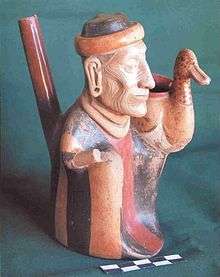
One of the most striking South American legends concerns the Creator/Sun God - Kon-Tiki Viracocha, the most universal god of most of the Andean cultures. According to Andean legend, he appeared as a white skinned, bearded man. He created man and the civilization and city of Tiwuanaco in Bolivia. Tiwuanaco was built complete with stepped pyramids, human rock figures, and stone work of precise fitting large blocks using reed rafts to transport the large blocks of stone to the site. When his work was done he walked to the coast with some of his followers and disappeared to the west across the sea, following the setting sun. At about the same time, according to Easter Island legend, the first settlers arrived from the east. Could Viracocha have been the first settler of Easter Island carrying the seeds of civilization?
Perhaps there is no greater indicator to the movements of early man than the botanical evidence. There are several plant species that were found to be used in both Polynesia and South America by the first European explorers upon their discovery of those regions. They are all useful plants that a settler of new lands would likely have taken on a long voyage. The plant list includes the totora reed (Scirpus riparius) which the expedition's first reed ship has been constructed of. It grows on the shores of Lake Titicaca near Tiwuanaco and in the crater lakes of Easter Island. Other useful plants found in both regions include the tomato, sweet potato, tobacco, the bottle gourd, papaya, the wild pineapple, yam and coconut palm. Many of these plant species which has been found to have existed longer in the Americas than Polynesia, suggests a western migration from South America. Most of these plants could only have been transported by man, the seeds of which could not have survived the long ocean drift or a bird's migratory flight. The great number of American crop plants that can be shown as pre-European in Polynesia tells the story of overseas voyages.
The objective of the first two voyages was to reinforce the theory that ancient mariners could have crossed oceans using trade winds and ocean currents to explore the globe, well before the time of Columbus. Our voyage was the first to link the ancient civilizations of Tiwuanaco on the shores of Lake Titicaca, Bolivia and the isolated Easter Island of the Pacific, demonstrating that there could have been contact between two of the most mysterious civilizations of antiquity. No reed ship or other recreated ancient craft has made this voyage in modern times. The Viracocha I set sail from Arica, Chile, the closest sea port to the ancient civilization of Tiwuanaco. The crew followed the natural human conveyor belt of the Humboldt Current to within 500 miles of one of the most isolated places on the planet, Easter Island. The final 500 miles were the most difficult, requiring tacking into the wind and working against circular vortex currents to reach the island.
The Viracocha II began in Viña del Mar, Chile in the year with the intended destination of Australia. A bad launch severely damaged the raft and Easter Island was the farthest the raft could travel. However, the expedition showed once again that ancient South American mariners could have been first to reach Easter Island.
The Viracocha III expedition
Fifteen years later, the Viracocha III reed raft was to attempt the complete crossing of the Pacific in February 2018.[6] but the launch date has had to be postponed for technical reasons.[7] The expedition intended follow in the wake of the Kon-Tiki Viracocha people and their impulse to follow the setting sun and desire to spread the seeds of civilization ever westward. Like the Virachocha I the Viracocha III was scheduled to sail from Arica, Chile, to Mangareva, in French Polynesia, and from there attempt to island-hop to Australia.
References
- Thorpe, Nick (2003). Eight Men and a Duck. London: ABACUS. ISBN 0 349 11454 4.
- "Spanish adventurer crosses Pacific in reed boat". CNN. REUTERS. 13 May 1999. Retrieved 21 April 2017.
- Pollard, Thom. "Viracocha II Reedship Expedition Part 1". Youtube. Retrieved 17 April 2017.
- Pollard, Thom. "VIRACOCHA REED SHIP EXPEDITION PART 2". Youtube. Retrieved 17 April 2017.
- Pollard, Thom. "The Disastrous Launch of the Viracocha II". Vimeo. Retrieved 17 April 2017.
- O'Brien, Rosalba (19 October 2016). "Reed boat expedition readies to cross Pacific, prove ancient journeys". REUTERS. Retrieved 17 April 2017.
- "La Viracocha III aún no tiene fecha exacta para ser botada". La Estrella de Arica. 19 February 2018. Retrieved 13 April 2018.